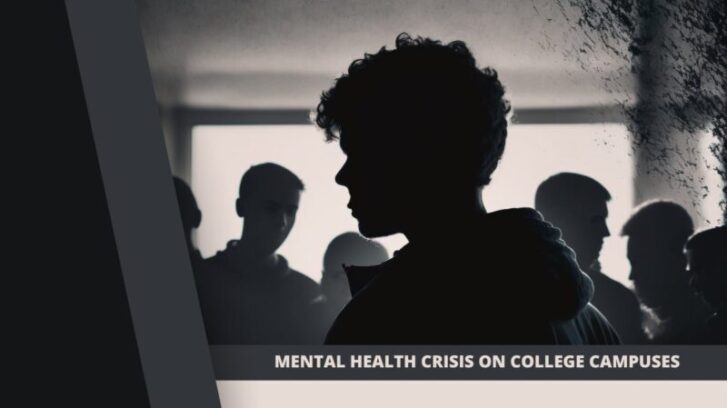The mental health crisis on college campuses is a growing concern that demands immediate attention. College years are a critical period in a person’s life, marked by significant changes, challenges, and transitions. While these years can be exciting and transformative, they can also be a time of immense stress and vulnerability, leading to a surge in issues among college students.
The importance of addressing mental health issues in the college population cannot be overstated. Mental health is a key component of overall well-being and plays a crucial role in academic success, personal development, and quality of life. Moreover, college students are at a stage where they are forming habits and attitudes that will shape their future mental health.
Ignoring crises on college campuses can have serious repercussions, not just for the students themselves, but also for the wider society. It is therefore essential to understand the scope of the problem, identify the contributing factors, and explore effective strategies to address this crisis.
Prevalence of Mental Health Issues Among College Students
The prevalence of issues among college students is alarmingly high. According to the American College Health Association, nearly 60% of college students reported feeling overwhelming anxiety, while 40% reported feeling so depressed that it was difficult to function. These figures underscore the severity of the mental health crisis on college campuses.
Common mental health disorders affecting college students include anxiety disorders, depression, eating disorders, and substance abuse disorders. These conditions can significantly impair a student’s ability to function, affecting their academic performance, social relationships, and overall quality of life.
Research also indicates that many college students are struggling with issues but are not receiving the help they need. A study published in the Journal of Adolescent Health found that among college students with mental health conditions, 45% did not seek help. This highlights the need for increased awareness, accessibility, and utilization of services on college campuses.
Factors Contributing to the Crisis
Several factors contribute to the mental health crisis on college campuses. Academic pressure and stress are major contributors, with students facing high expectations, rigorous coursework, and intense competition. This can lead to chronic stress, burnout, and an increased risk of disorders.
Financial burdens and concerns are another significant source of stress for college students. The rising cost of tuition, coupled with the pressure to secure employment after graduation, can lead to financial stress and anxiety. This can be particularly challenging for students from low-income families or those who are working while studying.
Social isolation and loneliness, transition and adjustment challenges, and substance abuse and addiction are other key factors contributing to the crisis. College students often struggle with feelings of loneliness and homesickness, difficulty adjusting to a new environment, and the temptation to engage in risky behaviors such as substance abuse.
Consequences of Untreated Mental Health Issues
The consequences of untreated mental health issues among college students are far-reaching. Academically, students with mental health disorders are more likely to have lower GPAs, drop out of college, or take longer to graduate. This can have long-term implications for their career prospects and earning potential.
On a personal level, untreated issues can affect relationships and social functioning. Students may struggle with interpersonal relationships, experience social withdrawal, or have difficulty participating in campus life. This can further exacerbate feelings of isolation and loneliness.
Perhaps most concerning is the increased risk of self-harm and suicide among college students with untreated mental health issues. According to the Centers for Disease Control and Prevention, suicide is the second leading cause of death among college-age individuals. This underscores the urgent need for effective mental health interventions and support systems on college campuses.
Campus Resources and Support Systems
Many colleges and universities offer a range of resources and support systems to address issues. Counseling and mental health services are typically available on campus, providing individual therapy, group therapy, crisis intervention, and psychiatric services. These services can play a crucial role in identifying, treating, and managing mental health disorders among students.
Peer support programs and student organizations can also be valuable resources for students struggling with mental health issues. These programs provide a safe and supportive environment where students can share their experiences, learn from each other, and develop coping strategies. They can also help reduce stigma and promote a sense of community and belonging.
Academic accommodations and wellness initiatives are other important components of campus support. These may include flexible deadlines, reduced course loads, and wellness programs that promote healthy behaviors such as regular exercise, balanced nutrition, and stress management.
Challenges in Accessing Support
Despite the availability of these resources, many college students face challenges in accessing mental health support. One major barrier is insufficient resources and long wait times. Many college counseling centers are understaffed and overwhelmed, leading to long wait times and limited availability of services.
Stigma and cultural barriers can also prevent students from seeking help. Many students fear being judged or misunderstood, while others may come from cultures that do not recognize or accept mental health disorders. This can make it difficult for these students to acknowledge their struggles and seek help.
Lack of awareness and knowledge about available services is another significant barrier. Many students are not aware of the mental health resources available on their campus or do not know how to access them. This highlights the need for increased outreach and education about services.
Strategies to Address the Crisis
Addressing the mental health crisis on college campuses requires a multifaceted approach. Increasing funding and resources for mental health services is a critical step. This can help reduce wait times, increase the availability of services, and ensure that students receive the help they need.
Promoting mental health awareness and destigmatization is another important strategy. This can be achieved through education campaigns, workshops, and events that raise awareness about issues, challenge misconceptions, and promote a supportive and inclusive campus culture.
Implementing preventive measures and early intervention programs can also be effective in addressing the crisis. These programs can help identify students at risk, provide timely intervention, and prevent the escalation of issues.
Collaboration Between Different Stakeholders
Collaboration between different stakeholders is key to addressing the mental health crisis on college campuses. College administrators and faculty play a crucial role in creating a supportive and inclusive campus environment, recognizing signs of distress among students, and connecting students with appropriate resources.
Cooperation with mental health professionals and organizations can also enhance the quality and effectiveness of campus services. This can include partnerships with local clinics, consultation with psychiatrists and psychologists, and collaboration with national organizations.
Engaging students in advocacy and decision-making processes is another important aspect of this collaboration. Students can provide valuable insights into the needs and concerns of the campus community, advocate for improved services, and contribute to the development and implementation of policies and programs.
Case Studies and Success Stories
Highlighting colleges with effective programs can provide valuable insights and inspiration for other institutions. For example, the University of Michigan’s Counseling and Psychological Services (CAPS) has been recognized for its comprehensive range of services, proactive outreach efforts, and strong commitment to diversity and inclusivity.
Sharing personal stories of students who have overcome mental health challenges can also be powerful and inspiring. These stories can help reduce stigma, foster a sense of hope and resilience, and remind students that they are not alone in their struggles.
These case studies and success stories underscore the potential for positive change and the importance of continued efforts to address the crisis on college campuses.
Future Directions and Recommendations
Looking forward, continued research and data collection are essential to understanding the evolving mental health needs of college students and evaluating the effectiveness of current interventions. This can inform the development of evidence-based policies and programs that address the unique challenges and stressors faced by college students.
Policy changes and legislative efforts can also play a crucial role in addressing the mental health crisis. This can include policies that increase funding for mental health services, mandate mental health education, and protect the rights of students with disorders.
Building a comprehensive and holistic approach to mental health on campuses is another key recommendation. This involves integrating into all aspects of campus life, promoting a culture of wellness, and ensuring that all students have access to the support and resources they need to thrive.
FAQ
What are some signs that a college student might be struggling with their mental well-being?
Changes in behavior can often indicate a student is struggling. This might include a drop in academic performance, changes in eating or sleeping habits, withdrawal from social activities, or increased use of alcohol or drugs. They may also express feelings of hopelessness, and worthlessness, or talk about self-harm.
How can parents support their college-age children’s emotional well-being?
Parents can support their children by maintaining open lines of communication, encouraging them to use available resources, and educating themselves about the signs of emotional distress. It’s also important to remind them that seeking help is a sign of strength, not weakness.
Are online mental wellness resources effective?
Yes, online resources can be very effective and have the advantage of being accessible anytime, anywhere. These can include online counseling services, mental wellness apps, and online support groups. However, they should not replace professional help if a student is in crisis.
How can students balance their academic responsibilities with self-care?
Time management is key. Students should try to establish a routine that includes time for studying, relaxation, and physical activity. It’s also important to take breaks when needed and to ensure they are getting enough sleep and eating a balanced diet.
What role do professors play in supporting students’ emotional well-being?
Professors can play a significant role by creating a supportive learning environment, being aware of the signs of emotional distress, and directing students to appropriate resources. They can also incorporate wellness topics into their curriculum and be flexible with students who are dealing with emotional health issues.
Are there any specific programs or initiatives that have been particularly successful in promoting emotional well-being on college campuses?
Yes, programs that take a comprehensive approach to wellness have been particularly successful. For example, the JED Campus program works with colleges to assess and enhance mental health, substance use, and suicide prevention efforts. Similarly, the Healthy Minds Study is an annual survey that provides colleges with data on their students’ emotional health to guide programming and policy decisions.
How can students get involved in promoting emotional well-being on their campus?
Students can get involved by joining or starting student organizations focused on wellness, participating in awareness campaigns, advocating for policy changes, or training to become peer counselors. They can also support their peers by listening, expressing concern, and encouraging them to seek help when needed.
What should a student do if they are in crisis or concerned about a friend who may be in crisis?
If a student is in crisis, they should immediately contact their campus counseling center or a crisis hotline such as the National Suicide Prevention Lifeline. If they are concerned about a friend, they should express their concern, encourage their friend to seek help and notify a trusted adult if they believe their friend is in immediate danger.
Conclusion
The mental health crisis on college campuses is a complex and pressing issue that requires concerted efforts from all stakeholders. While the challenges are significant, the potential for positive change is immense. By understanding the scope of the problem, recognizing the contributing factors, and implementing effective strategies, we can create a supportive and inclusive campus environment where all students can thrive.
The call to action is clear: we must prioritize mental health on college campuses, invest in resources and support systems, and foster a culture of understanding and compassion. Only then can we ensure that our colleges and universities are places of learning, growth, and well-being for all students.
Related Posts:
- Family Support in Mental Health Treatment:…
- Women Mental Health and Anxiety: Breaking the…
- 16 Best Mental Health Blogs 2024 - Finding Hope and Support
- Dream About Bats Meaning: Fear, Change, Power & More
- Black Cat Dream Meaning and Interpretation - What It…
- Tiger in Dream Meaning: Power, Authority & More -…

















